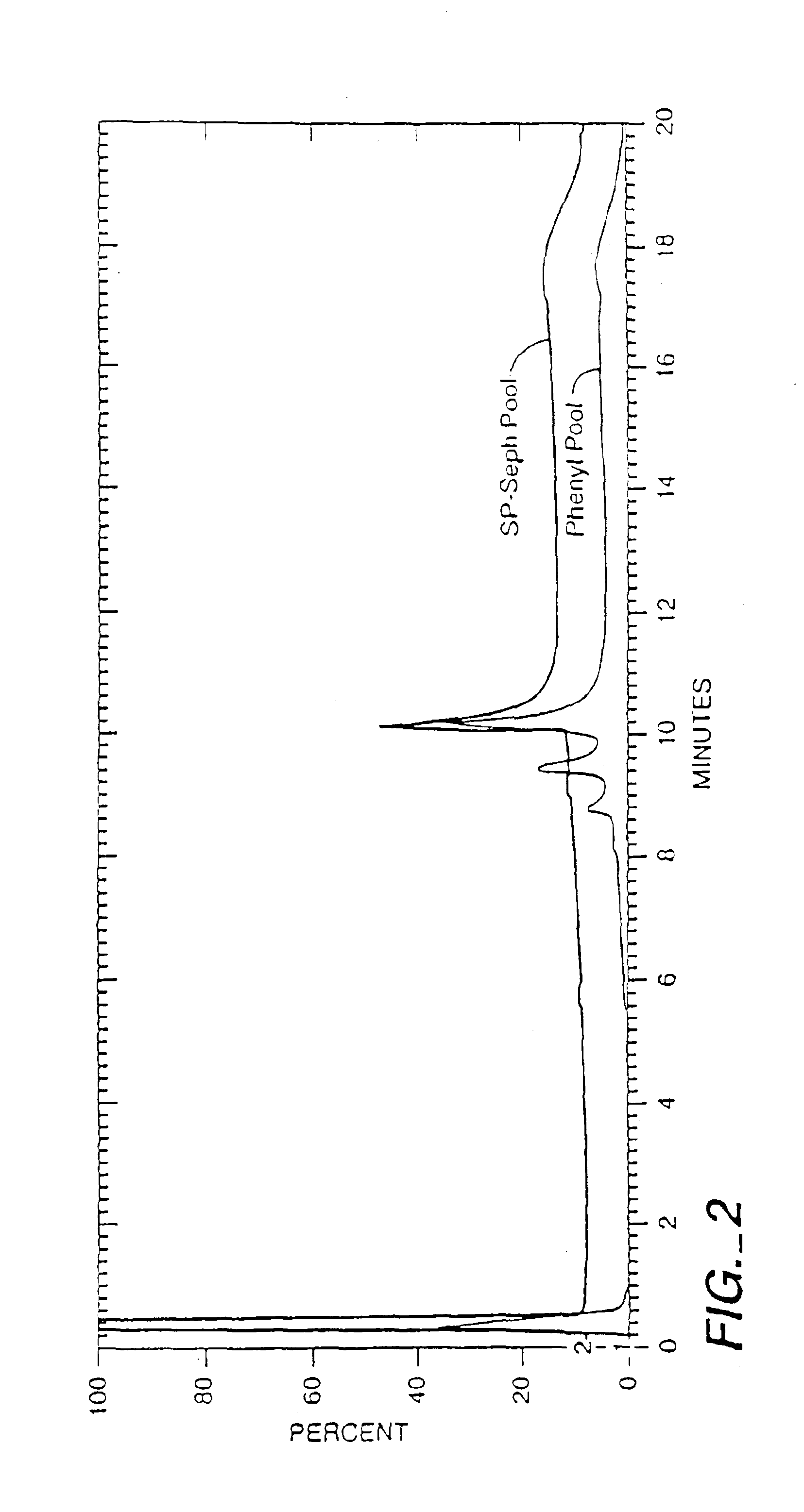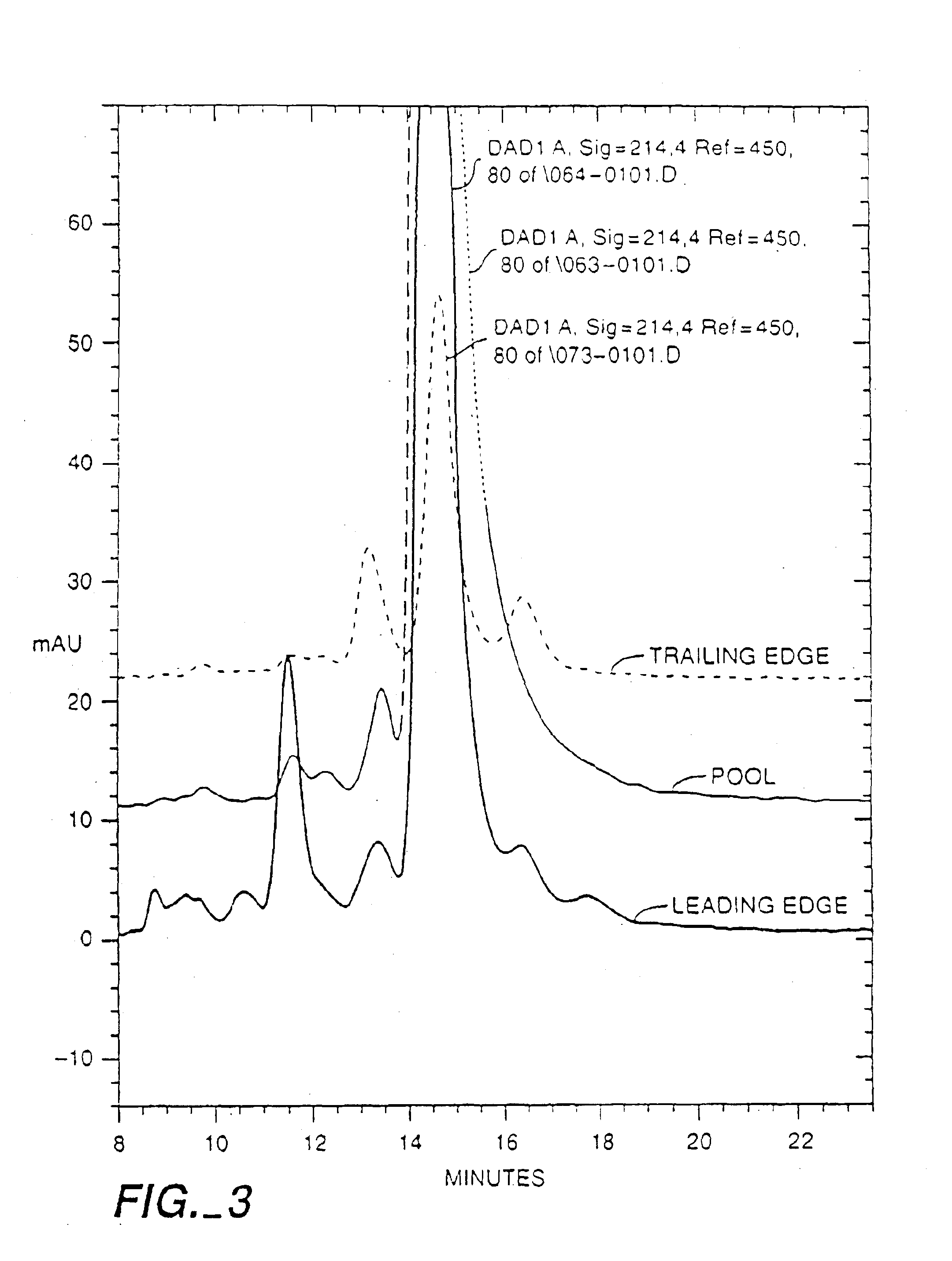Isolation of neurotrophins from a mixture containing neurotrophin variants using hydrophobic interaction chromatography
a technology of neurotrophin and mixture, applied in the field of purification of neurotrophins, can solve the problem of not being prepared from natural sources in sufficient quantities
- Summary
- Abstract
- Description
- Claims
- Application Information
AI Technical Summary
Benefits of technology
Problems solved by technology
Method used
Image
Examples
example 1
Purification of 118 / 118 NGF Homodimer
[0124]This example illustrates purification of NGF and the rationale for each step. As in each of the Examples, one skilled in the art can readily determine and adjust column dimensions and flow rates to compensate for initial culture volumes and protein concentrations as is well-known in the art.
Harvested Cell Culture Fluid
[0125]Recombinant CHO cell was transfected with an expression vector containing the 120 amino acid human NGF encoding DNA sequence. To promote secretion and processing the NGF prepro sequence was also present. After culturing of the recombinant CHO cells, the cell culture medium was harvested. The Harvested Cell Culture Fluid (HCCF) contained NGF. species 120, 118, and 117. About 40-70% of the NGF was typically a 118 / 118 homodimer with the remainder as heterodimers 120 / 118, 120 / 120, and a small amount as 118 / 117. As taught herein, these species can be separated by the SP-Sepharose HP column.
[0126]Harvested Cell Culture Fluid w...
example ii
Purification of the 120 / 120 NGF Homodimer at Large Scale
Harvested Cell Culture Fluid
[0137]HCCF was obtained from a 12,000 liter CHO cell culture generally as described in Example I. The NGF species distribution in the HCCF was about 40-65% 120 / 120 homodimer with 120 / 118 heterodimer with the remaining as 118 / 118 homodimer. The medium was typically quickly processed to minimize proteolytic conversion of 120 to 118.
Macroprep High S Cation-Exchange Chromatography
[0138]The HCCF was loaded onto a Macroprep High S Cation-Exchange Chromatography column, washed with 1.5 M sodium acetate, 50 mM HEPES pH 7. Bound NGF was eluted with 1.5 M NaCl, 0.25 M TMAC, 0.2% thiodiglycol, pH 7. The Macroprep column can be run at pH 5 to 8 with adjustment of the acetate concentration. Chloride is a preferred substitute for acetate ion. The NGF eluted due to the TMAC gradient. TMAC is a salt having both ionic and hydrophobic character, which is a useful property since the backbone support of some resins cont...
example iii
Isolation of 118 / 118
[0147]In one preferred embodiment to obtain a substantially pure 118 / 118 NGF composition that is substantially free of NGF variants, the method of Example It was followed with the following modifications. An immobilized trypsin column is used between the Macroprep High S column and the Silica column. The Macroprep pool is directly loaded onto the immobilized trypsin column, after adjusting the pH to between about pH 5 to 8.5, most typically 6.5 to 7.5, if necessary. The pool was passed through the column during which time most of the NGF was converted to the 118 form. The protease digestion converts the 120 form to the 118 form by cleavage of the C-terminal VRRA to VR. To achieve the limited and selective cleavage, a trypsin or trypsin-like protease is used, preferably trypsin, more preferably the readily available porcine trypsin, or alternatively bovine trypsin or a recombinant trypsin. Any proteolytic method that provides substantially limited and selective cl...
PUM
| Property | Measurement | Unit |
|---|---|---|
| Fraction | aaaaa | aaaaa |
| Fraction | aaaaa | aaaaa |
| Fraction | aaaaa | aaaaa |
Abstract
Description
Claims
Application Information
 Login to view more
Login to view more - R&D Engineer
- R&D Manager
- IP Professional
- Industry Leading Data Capabilities
- Powerful AI technology
- Patent DNA Extraction
Browse by: Latest US Patents, China's latest patents, Technical Efficacy Thesaurus, Application Domain, Technology Topic.
© 2024 PatSnap. All rights reserved.Legal|Privacy policy|Modern Slavery Act Transparency Statement|Sitemap



